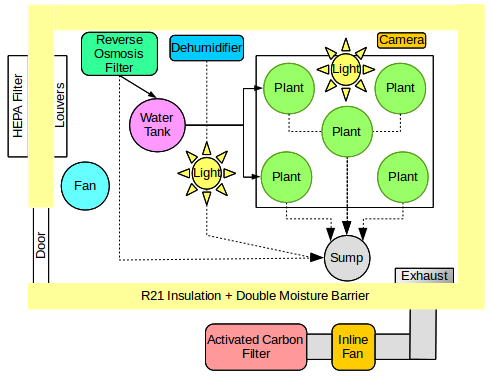Inspiration
In 2013, the Humble Roots Project was born out of a need to grow medical cannabis indoors legally, using sustainable, organic, pesticide-free cultivation methods capable of producing consistent yields, in both quality and quantity.
Medical cannabis patients and caretakers who have determined that investing in their own garden is financially sound and healthy still face several challenges: cannabis can be tricky to grow, requires constant care and a well-controlled climate in order to thrive.
While commercial greenhouse automation controllers are well-suited for this task, they're also expensive, proprietary, closed source solutions. Small scale growers typically resort to using 'low-tech' or 'no tech' solutions (i.e lights and irrigation on timers, climate control using a basic thermostat and humidistat) at the risk of losing entire crops.
The Humble Roots Project was built to fill the gap between commercially available automation systems and low-tech solutions. By automating the control of key processes, and by following some basic best practices, the Humble Roots Project empowers gardeners with the knowledge and the tools needed to reduce certain classes of risks, to minimize manual labor and to conserve precious resources, such as water and power.
To mitigate the steep learning curve associated with cannabis cultivation, the Humble Roots Project aims to provide recipes for growing different types of plants. A recipe is a complete plan for managing the growth cycle of a plant from seed/clone to harvest, including variables such as watering and feeding schedules, lighting schedule, temperature and humidity control, among others. The recipes are meant to educate and guide the budding gardener, as well as allowing a master grower to experiment with and fine-tune the quality and consistency of her yields.
Indoor Growing Basics
In order to understand the components of the Humble Roots Project, it is worth covering the basic requirements for indoor growing, such as:
- Garden Space and Equipment
- Plants and Growing Medium
- Control System
Garden Space
An indoor garden should be a secure, insulated space that keeps out moisture, heat and cold, pests and unfiltered air. Here, the Humble Roots Project is a 9' x 12' ft indoor garden space built inside of a home car garage. The following diagram provides a simplified view of the Humble Roots garden space as it is organized today. It will be referenced when discussing the integration of the environment with the devices, hardware and software used to control it. The space is reconfigurable and uses parts commonly available on-line or from local hardware stores and nurseries.
The elements that need to be considered when setting up an indoor garden space are: thermal efficiency, lighting efficiency, water treatment, water conservation and air quality control.

Thermal Efficiency
When
designing an indoor garden, it is important to make sure the room has
high thermal efficiency. Thermal efficiency is important because it
has a direct impact on the resources dedicated to heating and cooling
the garden space.
For the Humble Roots Project, the garden is located in a room elevated above ground to prevent the floor from getting too cold during the winter months. The floor, the walls and the ceiling are filled with R21 insulation material. The insulated material is sandwiched between two plastic moisture barriers. The door is made of metal, can be locked and seals tightly with its frame. Because the room is well insulated, it allows for semi-passive cooling and saves a great deal of energy in the process since an air conditioning unit is not required. Passive cooling relies on a temperature differential between cool outside air and warm air inside of the room. A fan draws cool air inside the room while exhausting warm air.
Running the system at night, when lights are on, ensures that the temperature difference between the two zones is adequate for passive cooling. It also makes operating the garden ...
Read more » Fabien Royer
Fabien Royer


 Frank Vigilante
Frank Vigilante
 Guillermo Perez Guillen
Guillermo Perez Guillen
 Davor
Davor
 Uncle Toby and Aquaman
Uncle Toby and Aquaman
That's great , we can grow several others plants indoor which are beneficial and healthiest as well as a source of income see more at https://microgreensworld.com/